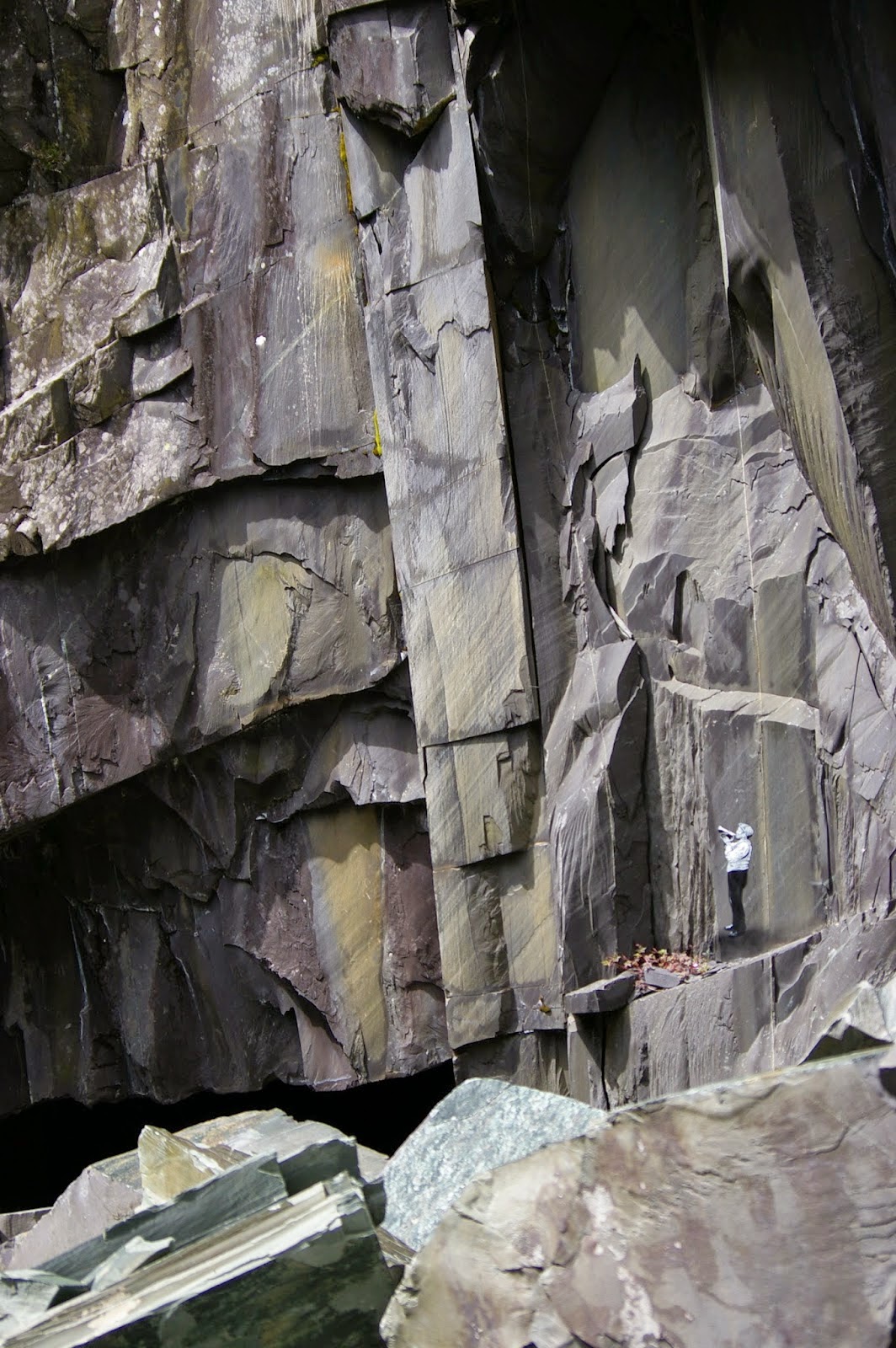Photo:MaryMary
Geography mutates inhabitants: the quarrymen, generation
upon generation, dug in, taking hits and diminishing the mountain for the
demanded slate; day after day, lung after lung, producing a lethal strain in
the indigenous population. A package deal of volatile deliverance and bought
pleasure from Ebenezer's Kingdom. Time left those dusty appendages and
tale full jars to eke out in some other field. They left a huge dead quarry,
into which the micro-quarrymen came; reluctantly at first, to work and play and
exert their recreational rules, and again, to become prey to a different sort
of mutation — a more intellectual, dare I say, "artistic" Manic
Strain!
The rock-climbers, tier upon tier of them, are the micro-quarrymen,
milling about their business on the faces and slabs, like termites — feeling
and probing. The demand to cap roofs around the world, has left this place a
climbers' paradise, or perhaps a climbers' dungeon? A dungeon of climbers, some
touching, some hacking this friable substance — some tentative, some robustly
forging lines — exerting their own character on the structure left behind.
"Love Sculpture" as someone put it! Creative sculpture does exist
here — it's also matched by blatant thuggery.
There are no rules for production
here. There are no lines drawn between the poet exercising his urge and a team
of navvies next door, hell bent on ascent! Each justifies their Strain. The
difference between a wall where there was nothing, carefully chipped to produce
a series of moves that give the discerning "dancer" unsurpassed climbing
pleasure.....Manic Strain, E7 6b/c and a climbable line, cleaned and chipped to
produce an easier route for the first ascentionist, lies in the former being a
series of subtle, aesthetic changes, that neither looks, nor feels, chipped, as
opposed to blatantly produced jugs.
Both are bolt protected, and both valid.
This is the essence of the quarry activity. The movement is constant and
without constraint. It is both honest and deceiving; both aesthetic and ugly.
Just like the light on wet, varnished slate clearly defines shape upon shape
and changing depths of reflected colour from strange sources. It cannot stand
still — it is with the stroke of movement. As for the mentality, it is obvious.
A tiny flake is levered off whilst cleaning, producing a better hold or nothing
at all. On the former you make it secure, and give it the wire; but on the
latter, you could have a choice? You want the line to go, it's yours, a lot of
effort, the expense of bolts — you say, "it will go", and depending
on the `strain' acting on you, a hold is chipped, or you can leave it for
someone better? This choice, brought about by Slate's limited, but intense history,
just isn't applicable.
This isn't Clogwyn du Arddu. We are here on what's left
of the destruction of a hillside- a mountain — you don't even consider the
environment. This is "all the throes of climbing pleasure",
unrestricted amidst a moraine of slate debris, of oil drums and iron bars,
skeletal machinery and stacks of discarded nude books. There cannot be any
respect for the rock, giving unlimited lines from the Lake Padarn to the
clouds. Will it hell be left for someone better — the better are too busy doing
their own thing, and anyway, you, already have a name for it! Do you not find
this sinister in its possible encroachment down the Pass? There is
room here for conjecture. Like the lad who's just started climbing — straight
into slate, on an abseil rope, with tools and excavating equipment, producing
minor routes, with no experience, or "apprenticeship", no feel of
what's gone before, and elsewhere. Caught by colour and proximity, dug the
style, and hitched straight in.
Could there be a strange, twisted analogy here
of a quarryman's son, destined to spend his days with the dust, with
like-minded disinterested in the Welsh mountain surroundings. A slate breed- a
mutant. Differing circumstances, differing strains-same quarry: Right here on
the ravaged hillside, in a throw from Pete's Eats are ten-fold “Cloggy's",
from Dinorwig's Big Hole and of above, down through Australia, and Dali's dip
to California — to Serengetti, tier upon tier down to the Rainbow Slab Area,
and in across, and down inclines to the more accessible Vivian Quarry. Yawn!
Don't relax there’s a Steerpike around every corner.
A lot of unstable
characters play out their visions and anarchy here; one indeed seems to forget
the 'link' with climbing. Tests indeed. Offset and lethal waves fusing out of
the surroundings — characters can be changed and possessed as easily as winding
up a Power Station official. Perhaps from a fictitious "Arfonwy
Roberts", bent double in 1806, for the pleasure of some unknown "Dust
Queen", high up in a tunnel near the Big Hole. Lines were lost, goitres
were brown — a strain embedded into the rock — their character and lives
permeated into every fought for vein; its greyness exuding their dangerous
misery.
John Redhead on 'Menstrual Gossip-E7
The pounding of ancient powdery hard-ons in remote cutting sheds
(listen) — cut-throats and camaraderie, of manhood, the depraved and the
proud. All etched indelibly for your young prancing limbs on smooth slabs. And
the climbers, so young with the dust they haven't learned to cry yet. But each
one that steps up the tiers or inclines, and jokes along the levels, as before,
is tracing a destiny; is being absorbed by the oozing spirit of this place — in
dark cave, or hanging flake, the clanging of real men about their work, with
their problems and perversions, is stilled before them — ever-present and
affecting. Varnished by rain, or dulled by dust — You can skip out — a mutant
at every level. May the Manic Strain be with you.
John Redhead : First published in Climber-Nov86. Photos JR collection unless stated.
Photos available from JohnRedhead Org







.jpg)


.jpg)
